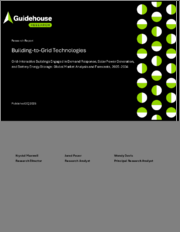
|
시장보고서
상품코드
1714075
세계의 B2G(Building-to-Grid) 시장Building-to-Grid: Grid-Interactive Buildings Engaged in Demand Response, Solar Power Generation, and Battery Energy Storage - Global Market Analysis and Forecasts, 2025-2034 |
||||||
증가하는 에너지 수요를 충족하고 재생 가능한 분산형 에너지 자원(DER)의 도입을 관리하기 위해 전 세계 전력망이 스트레스를 받고 있는 가운데, 전력회사는 전력망을 안정화시켜야 하는 상황에 직면해 있습니다. 건물과 전력망의 상호 작용을 가능하게 하고 전력망의 자원으로 작용하는 B2G(Building-to-Grid) 기술은 적절히 관리된다면 전력망 안정화에 도움이 되는 효과적인 솔루션입니다. 이러한 기술은 전력회사, 건물 소유자, 주택 소유자, 정부, 에너지 소비자에게 직접적인 혜택을 제공합니다.
시장 환경은 B2B 통합의 확대에 유망합니다. 세계 각국이 전력망 안정화 및 탈탄소화를 위해 노력하고 있는 가운데, B2B 통합은 이러한 목표를 달성하는 데 있어 중요한 요소가 될 것으로 보입니다. 또한, 건물주 및 주택 소유자의 전력망 참여에 대한 관심이 높아짐에 따라 B2G를 가능하게 하는 기술이 더욱 선호되고 있는 것은 전 세계적으로 도입이 증가하고 있는 것을 보면 알 수 있습니다. 어떤 기술, 비즈니스 모델, 정책이 정착될 것인지에 대해서는 많은 의문이 남습니다.
본 보고서는 수요반응, 태양광 발전, 축전지라는 세 가지 주요 B2G 기술과 연계된 계통연계형 빌딩의 주요 동향을 분석합니다. 본 보고서에서는 이들 B2G 기술의 개요와 채택을 촉진하는 요인과 성장을 제한하는 요인에 대해 설명합니다. 또한 2025년부터 2034년까지 그리드 인터랙티브 빌딩의 수를 기술별, 건물 유형별(상업용, 시설용, 주거용), 지역별로 예측했습니다. 이 보고서는 그리드 안정화를 지원하는 B2B 기술을 촉진하기 위해 B2B 이해관계자들에게 구체적인 제안으로 마무리됩니다.
목차
제1장 주요 요약
제2장 시장 문제
- 기술 개요
- 수요반응
- 분산형 발전
- 분산형 에너지 저장
- 성장 촉진요인
- 그리드 안정성 필요성
- 그리드 참가에 대한 관심 증가
- 실현 기술 보급
- 트란자크티브에네르기 출현
- 정책과 규제
- 성장 억제요인
- 고액의 초기 비용
- 불충분한 인식, 장려책, 수용
- 기존 에너지 비즈니스 모델과 변화하는 정책
- 피크 수요 문제
제3장 산업 밸류체인
- 경쟁 구도
- 산업 밸류체인
- 태양광발전과 배터리 에너지 저장
- 수요반응
제4장 시장 예측
- 조사 방법
- 수요반응 예측
- 태양광발전 예측
- 배터리 에너지 저장 예측
- 지역 시장 예측
- 북미
- 유럽
- 아시아태평양
- 기타 국가
제5장 결론 및 제안
- 3대 포인트
- 추천 사항
- 유틸리티
- 정부
- B2G 기술 제공업체
제6장 두자어 및 약어 리스트
제7장 목차
제8장 도표
제9장 조사 범위, 정보원과 조사 방법, 주석
LSH 25.05.13As global electric grids are put under stress to meet growing energy demands and manage the introduction of more renewable distributed energy resources (DER), utilities will face more pressure to stabilize the grid. Building-to-grid (B2G) technologies-which enable buildings to interact with the electric grid and act as a grid resource-are effective solutions that, if managed properly, can help with grid stabilization. These technologies can directly benefit utilities, building owners, and residential homeowners as well as governments and energy consumers.
Market conditions are promising for increased B2G integration. As countries around the world work to stabilize and decarbonize their power grids, B2G integration will be a key component in achieving these goals. Additionally, increased interest in grid participation from building owners and residential homeowners have made B2G-enabling technologies more desirable, as evidenced by their increased adoption globally. Most of the barriers to B2G integration concern the market's maturity. As B2G integration is in its infancy, many questions remain about which technologies, business models, and policies will take hold as the market matures.
This Guidehouse Research report analyzes major trends in grid-interactive buildings engaged with three primary B2G technologies: demand response, solar power generation, and battery energy storage. The report provides an overview of these B2G technologies and the factors driving their adoption or limiting their growth. It forecasts the number of grid-interactive buildings, segmented by technology, building type (commercial, institutional, and residential), and region, from 2025 through 2034. The report concludes with specific recommendations for B2G stakeholders to promote B2G technologies in support of grid stabilization.
Table of Contents
1. Executive Summary
- 1.1 Scope
- 1.2 Market Drivers
- 1.3 Market Barriers
- 1.4 Global Market Outlook
2. Market Issues
- 2.1 Technology Overview
- 2.1.1 Demand Response
- 2.1.2 Distributed Electricity Generation
- 2.1.3 Distributed Energy Storage
- 2.2 Drivers
- 2.2.1 Need for Grid Stability
- 2.2.2 Increased Interest in Grid Participation
- 2.2.3 Proliferation of Enabling Technologies
- 2.2.4 Emergence of Transactive Energy
- 2.2.5 Policies and Regulations
- 2.3 Barriers
- 2.3.1 High Upfront Costs
- 2.3.2 Insufficient Awareness, Incentives, and Acceptance
- 2.3.3 Incumbent Energy Business Models and Shifting Policies
- 2.3.4 Peak Demand Issues
3. Industry Value Chain
- 3.1 Competitive Landscape
- 3.2 Industry Value Chain
- 3.2.1 Solar Power Generation and Battery Energy Storage
- 3.2.2 Demand Response
4.Market Forecasts
- 4.1 Methodology
- 4.2 Demand Response Forecast
- 4.3 Solar Power Generation Forecast
- 4.4 Battery Energy Storage Forecast
- 4.5 Regional Market Forecasts
- 4.5.1 North America
- 4.5.2 Europe
- 4.5.3 Asia-Pacific
- 4.5.4 Rest of World
5. Conclusions and Recommendations
- 5.1 Three Big Takeaways
- 5.2 Recommendations
- 5.2.1 Utilities
- 5.2.2 Governments
- 5.2.3 B2G Technology Providers



















